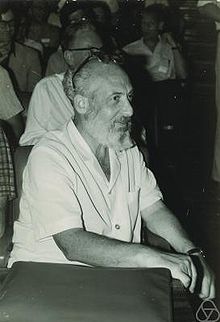Samuel Eilenberg
Samuel Eilenberg | |
|---|---|
 Samuel Eilenberg (1970) | |
| Born | September 30, 1913 |
| Died | January 30, 1998 (aged 84) New York City, United States |
| Citizenship | Russian, Polish, American |
| Alma mater | University of Warsaw |
| Known for | Acyclic model Category theory X-machine Weak dimension Projective module Shuffle algebra Simplicial set Standard complex Eilenberg's obstruction theory Eilenberg swindle Eilenberg–Ganea conjecture Eilenberg–Ganea theorem Eilenberg–MacLane space Eilenberg–Moore spectral sequence Eilenberg–Niven theorem Eilenberg–Steenrod axioms Eilenberg–Zilber theorem Cartan–Eilenberg resolution Chevalley–Eilenberg complex |
| Awards | Wolf Prize (1986) Leroy P. Steele Prize (1987) |
| Scientific career | |
| Fields | Mathematics |
| Institutions | University of Michigan Indiana University |
| Thesis | On the Topological Applications of Maps onto a Circle (1936) |
| Doctoral advisors | Kazimierz Kuratowski Karol Borsuk |
| Doctoral students | Jonathan Beck David Buchsbaum Martin Golumbic Daniel Kan William Lawvere Ramaiyengar Sridharan Myles Tierney |
Samuel Eilenberg (September 30, 1913 – January 30, 1998) was a Polish-American mathematician who co-founded category theory (with Saunders Mac Lane) and homological algebra.[1]
Early life and education
[edit]He was born in Warsaw, Kingdom of Poland to a Jewish family. He spent much of his career as a professor at Columbia University.
He earned his Ph.D. from University of Warsaw in 1936, with thesis On the Topological Applications of Maps onto a Circle; his thesis advisors were Kazimierz Kuratowski and Karol Borsuk.[2] He died in New York City in January 1998.
Career
[edit]Eilenberg's main body of work was in algebraic topology. He worked on the axiomatic treatment of homology theory with Norman Steenrod (and the Eilenberg–Steenrod axioms are named for the pair), and on homological algebra with Saunders Mac Lane. In the process, Eilenberg and Mac Lane created category theory.
Eilenberg was a member of Bourbaki and, with Henri Cartan, wrote the 1956 book Homological Algebra.[3]
Later in life he worked mainly in pure category theory, being one of the founders of the field. The Eilenberg swindle (or telescope) is a construction applying the telescoping cancellation idea to projective modules.
Eilenberg contributed to automata theory and algebraic automata theory. In particular, he introduced a model of computation called X-machine and a new prime decomposition algorithm for finite state machines in the vein of Krohn–Rhodes theory.
Art collection
[edit]Eilenberg was also a prominent collector of Asian art. His collection mainly consisted of small sculptures and other artifacts from India, Indonesia, Nepal, Thailand, Cambodia, Sri Lanka and Central Asia. In 1991–1992, the Metropolitan Museum of Art in New York staged an exhibition from more than 400 items that Eilenberg had donated to the museum, entitled The Lotus Transcendent: Indian and Southeast Asian Art From the Samuel Eilenberg Collection.[4][5] In reciprocity, the Metropolitan Museum of Art donated substantially to the endowment of the Samuel Eilenberg Visiting Professorship in Mathematics at Columbia University.[6][7]
Selected publications
[edit]
- Eilenberg, Samuel (1974). Automata, Languages and Machines, Volume A. Academic Press. ISBN 0-12-234001-9.
- Eilenberg, Samuel (1976). Automata, Languages and Machines, Volume B. Academic Press. ISBN 0-12-234002-7.
- Eilenberg, Samuel; Ganea, Tudor (1957). "On the Lusternik-Schnirelmann category of abstract groups". Annals of Mathematics. 2nd Series. 65 (3): 517–518. doi:10.2307/1970062. JSTOR 1970062. MR 0085510.
- Eilenberg, Samuel; Mac Lane, Saunders (1945). "Relations between homology and homotopy groups of spaces". Annals of Mathematics. 46 (3): 480–509. doi:10.2307/1969165. JSTOR 1969165.
- Eilenberg, Samuel; Mac Lane, Saunders (1950). "Relations between homology and homotopy groups of spaces. II". Annals of Mathematics. 51 (3): 514–533. doi:10.2307/1969365. JSTOR 1969365.
- Eilenberg, Samuel; Moore, John C. (1962), "Limits and spectral sequences", Topology, 1 (1): 1–23, doi:10.1016/0040-9383(62)90093-9, ISSN 0040-9383
- Eilenberg, Samuel; Niven, Ivan (1944). "The "fundamental theorem of algebra" for quaternions". Bulletin of the American Mathematical Society. 50 (4): 246–248. doi:10.1090/s0002-9904-1944-08125-1. MR 0009588.
- Eilenberg, Samuel; Steenrod, Norman E. (1945). "Axiomatic approach to homology theory". Proceedings of the National Academy of Sciences of the United States of America. 31 (4): 117–120. Bibcode:1945PNAS...31..117E. doi:10.1073/pnas.31.4.117. PMC 1078770. PMID 16578143.
- Eilenberg, Samuel; Steenrod, Norman E. (1952). Foundations of Algebraic Topology. Princeton, New Jersey: Princeton University Press. MR 0050886.[8]
See also
[edit]Footnotes
[edit]- ^ "Samuel Eilenberg - Biography". Maths History. Retrieved 2024-07-26.
- ^ Samuel Eilenberg at the Mathematics Genealogy Project
- ^ Mac Lane, Saunders (1956). "Review: Homological algebra, by Henri Cartan and Samuel Eilenberg". Bulletin of the American Mathematical Society. 62 (6): 615–624. doi:10.1090/S0002-9904-1956-10082-7.
- ^ Pace, Eric (February 3, 1998), "Samuel Eilenberg, 84, Dies; Mathematician at Columbia", The New York Times
- ^ "The Lotus Transcendent: Indian and Southeast Asian Art from the Samuel Eilenberg Collection - The Metropolitan Museum of Art". www.metmuseum.org. Retrieved 2024-07-26.
- ^ Bass, Hyman; Cartan, Henri; Freyd, Peter; Heller, Alex; Mac Lane, Saunders (1998). "Samuel Eilenberg (1913–1998)" (PDF). Notices of the American Mathematical Society. 45 (10): 1344–1352.
- ^ Yorke, Department of Mathematics at Columbia University New. "Department of Mathematics at Columbia University - FALL 2023 SAMUEL EILENBERG LECTURES". Retrieved 2024-07-26.
- ^ Spanier, Edwin H. (1958). "Review: Foundations of Algebraic Topology, by S. Eilenberg and N. Steenrod". Bulletin of the American Mathematical Society. 64 (4): 190–192. doi:10.1090/s0002-9904-1958-10204-9.
External links
[edit]- O'Connor, John J.; Robertson, Edmund F., "Samuel Eilenberg", MacTutor History of Mathematics Archive, University of St Andrews
- Eilenberg's biography − from the National Academies Press, by Hyman Bass, Henri Cartan, Peter Freyd, Alex Heller and Saunders Mac Lane.
- 1913 births
- 1998 deaths
- 20th-century American mathematicians
- Category theorists
- Columbia University faculty
- Nicolas Bourbaki
- Scientists from New York City
- Warsaw School of Mathematics
- People from Warsaw Governorate
- Polish emigrants to the United States
- 20th-century Polish Jews
- Topologists
- University of Warsaw alumni
- Wolf Prize in Mathematics laureates
- Members of the United States National Academy of Sciences
- Mathematicians from New York (state)
